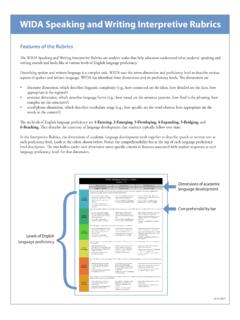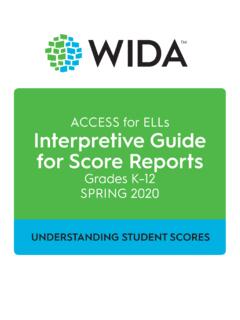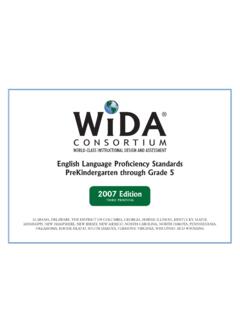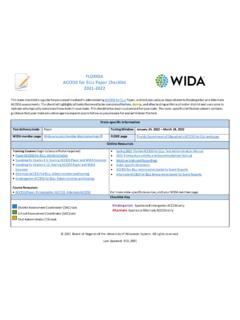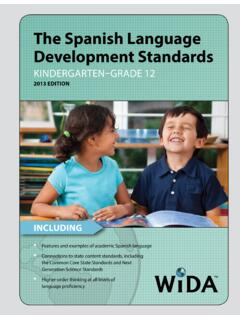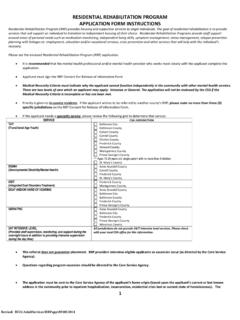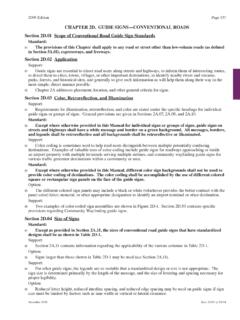Transcription of 2012 AMPLIFICATION OF The English Language Development ...
1 2012 AMPLIFICATION OF. The English Language Development Standards KINDERGARTEN GRADE 12. INCLUDING. Features and examples of academic Language Connections to state content standards, including the Common Core State Standards and Next Generation Science Standards Higher-order thinking at all levels of Language proficiency 2012 AMPLIFICATION OF. The English Language Development Standards KINDERGARTEN - GRADE 12. Copyright Notice WIDA's 2012 AMPLIFICATION of the English Language Development Standards, Kindergarten Grade 12. ( WIDA ELD Standards ) is owned by the Board of Regents of the University of Wisconsin System on behalf of the WIDA Consortium. The WIDA ELD Standards are protected by United States copyright laws and may not be reproduced, modified, or distributed, including posting, without the prior written permission of the Wisconsin Center for Education Research (WCER) and the Board of Regents of the University of Wisconsin System.
2 The WIDA ELD Standards are for your personal, noncommercial use only. You may not alter or remove any trademark, copyright, or other notice from copies of this booklet. Fair use of the WIDA ELD Standards includes reproduction for the purpose of teaching (including multiple copies). If you are not sure whether your use of this booklet and the WIDA ELD Standards falls within fair use or if you want permission to use the copyrighted WIDA ELD Standards for purposes other than personal or fair use, please contact the WIDA Client Services Center at or 1-866-276-7735. 2014 Board of Regents of the University of Wisconsin System, on behalf of WIDA Version Revised 2/6/17. iv Table of Contents and List of Figures Section 1: The WIDA Standards 3. 3. The WIDA English Language Development 4. Grade Levels and Grade-Level 4.
3 Developmentally Appropriate Academic Language in Sociocultural 4. Performance 5. Features of the Standards 8. Integrated, Expanded, and Complementary 12. Uses of the WIDA Standards Framework: Collaborate and Advocate!.. 12. Strands of Model Performance Indicators Representing the WIDA English Language Development Standards Section 2: Integrated 16. Kindergarten Grade 16. Grades 6 18. Section 3: Expanded 20. 20. Grade 22. Grade 24. Grade 26. Grade 28. Grade 30. Grade 32. Grade 34. Grade 36. Grades 9 38. Grades 11 40. Section 4: Strands by Grade 43. 44. Grade 50. Grade 56. Grade 62. Grade 68. Grade 74. Grade 80. Grade 86. Grade 92. Grades 9 98. Grades 11 104. 1. Appendices Appendix A: Glossary of Terms and Expressions Related to WIDA's Standards .. 110. Appendix B: Selected 114. Appendix C: Index of Strands by Grade 117.
4 Appendix D: Acknowledgements and Development 121. List of Figures Figure A: The WIDA Standards 3. Figure B: The English Language Development 4. Figure C: The Features of Academic 5. Figure D: WIDA Performance Definitions Listening and Reading, Grades K 6. Figure E: WIDA Performance Definitions Speaking and Writing, Grades K 7. Figure F: Standard, Grade Level, Example Topic, and 8. Figure G: Example Context for Language 8. Figure H: Cognitive 9. Figure I: Domain and Levels of Language 10. Figure J: A Model Performance Indicator (MPI) Within a 10. Figure K: Examples of Sensory, Graphic, and Interactive 11. Figure L: Topic-related 12. Figure M: Guiding Questions for Drafting Strands of 13. Figure N: A Blank Template for Drafting Strands of 14. 2. SECTION 1: The WIDA Standards Framework OVERVIEW. Introduction Figure A: WIDA Standards Framework The WIDA Standards Framework, depicted in Figure A, consists of a set of interactive and interdependent components that exemplify WIDA's vision for academic es of Language D.
5 In cipl eve r Language Development . This framework is the foundation gP lop in pro priate Aca for WIDA's work on Language Development standards. Ap id m lly de Gu en ta t m en The WIDA Standards Framework describes WIDA's ic L. pm Performance ang conceptualization of Language learning in addition to Develo Definitions uage the nature of academic Language and its relation to Language Development . It is represented by the following Standards &. components. their Matrices n s The WIDA Can Do Philosophy is based on the So t i ci o ex cultural Cont Ex y belief that all students bring to their learning cultural, m ph o e pl ify os experiential, and linguistic practices, skills, and ways of ing P hil the W o knowing from their homes and communities. WIDA IDA Can D. believes that as educators, our role is to craft instruction that capitalizes on and builds upon these assets.
6 The Guiding Principles of Language Development represent WIDA's core beliefs about Language Development . They are derived from a synthesis of literature and research related to Language Development and effective instructional practices for Language learners. The Features of Academic Language in Sociocultural Contexts highlight academic Language features across three dimensions: discourse, sentence, and word/phrase and six levels of Language proficiency taking into consideration the various components of the learning environment (grade level content, purposes for Language use, role relationships with others, and other factors). The Performance Definitions delineate the criteria for receptive Language (listening and reading) and productive Language (speaking and writing) at six levels of Language proficiency.
7 They are informed by the Features of Academic Language . The Can Do Descriptors illustrate what learners can do at each level of Language proficiency across the five Language Development standards. The Standards Matrices help educators envision what Language Development might look like in K 12. classrooms across levels of Language proficiency for each of the five standards. The matrices are used in conjunction with the Performance Definitions to describe possible student trajectories for academic Language Development . The components of the WIDA Standards Framework interact and influence each other in the design of curricula, Language instruction, and assessment of Language learners. Teachers and school leaders are encouraged to highlight specific components of the framework in their Language education programs to fit the specific needs of individual students and contexts.
8 In doing so, all stakeholders can participate in shaping the education of our increasingly rich and diverse student population. 3. OVERVIEW. The WIDA English Language Development Standards The WIDA English Language Development (ELD) Standards represent the social, instructional, and academic Language that students need to engage with peers, educators, and the curriculum in schools. Figure B shows the five standards and their abbreviations. Figure B: The English Language Development Standards Standard Abbreviation English Language English Language learners communicate for Social and Social and Development Instructional purposes within the school setting Instructional Standard 1 Language English Language English Language learners communicate information, ideas and The Language of Development concepts necessary for academic success in the content area of Language Arts Standard 2 Language Arts English Language English Language learners communicate information, ideas and The Language of Development concepts necessary for academic success in the content area of Mathematics Standard 3 Mathematics English Language English Language learners communicate information.
9 Ideas and The Language of Development concepts necessary for academic success in the content area of Science Standard 4 Science English Language English Language learners communicate information, ideas and The Language of Development concepts necessary for academic success in the content area of Social Studies Standard 5 Social Studies Standard 1 draws on students' personal experiences as they interact with teachers and peers. It works in conjunction with Standards 2 5 that address the Language of the content areas. Grade Levels and Grade-Level Clusters WIDA recognizes that English Language Development occurs over multiple years, is variable, and depends on many factors ( , age, maturation, classroom experiences, programming, motivation, and attitudes. With this in mind, WIDA has organized the ELD standards around individual grade levels from Kindergarten through 8th grade and for grade-level clusters 9 10 and 11 12.)
10 Having examples at the individual grade levels allows educators to recognize content topics pertaining to their grade and, most importantly, remind them that instruction for ELLs must be age and developmentally appropriate. As Language Development is a multi-year process, we encourage educators to look at examples of Language Development across a cluster of grades to get a fuller picture of the range of Language Development for their students. WIDA has a separate publication containing early Language Development standards for Pre- Kindergarteners (children ages ), as Language Development for this age group is unique. Developmentally Appropriate Academic Language in Sociocultural Contexts WIDA illustrates social, instructional, and academic Language as three dimensions: discourse dimension, sentence dimension, and word/phrase dimension.
